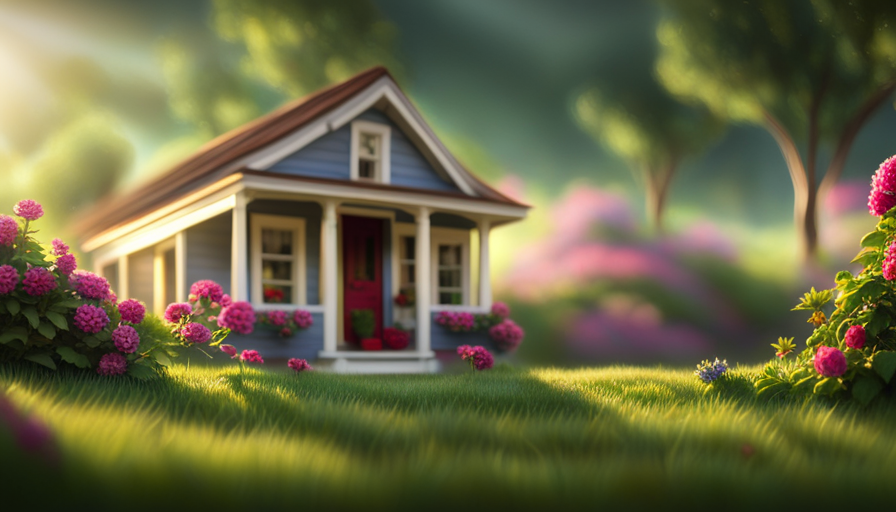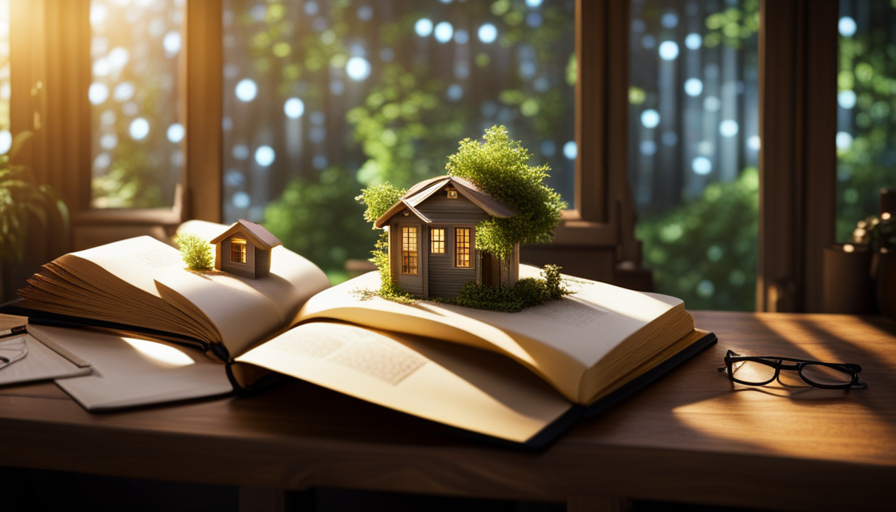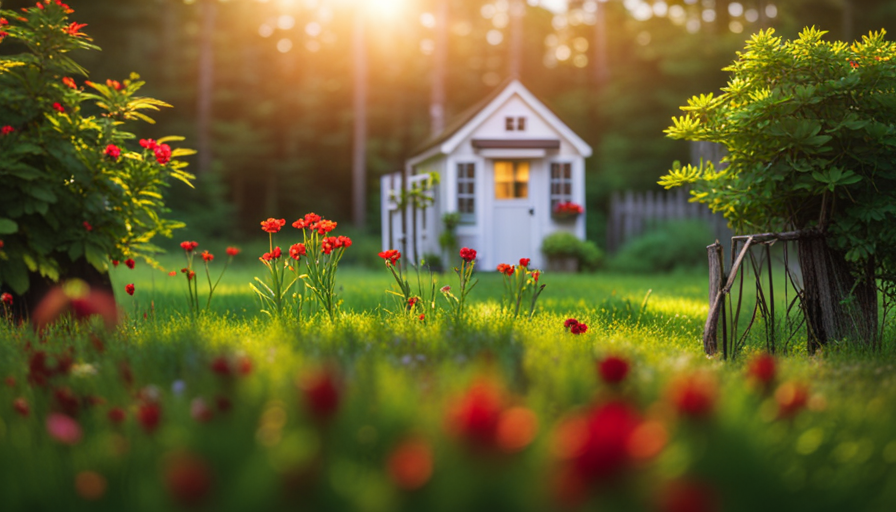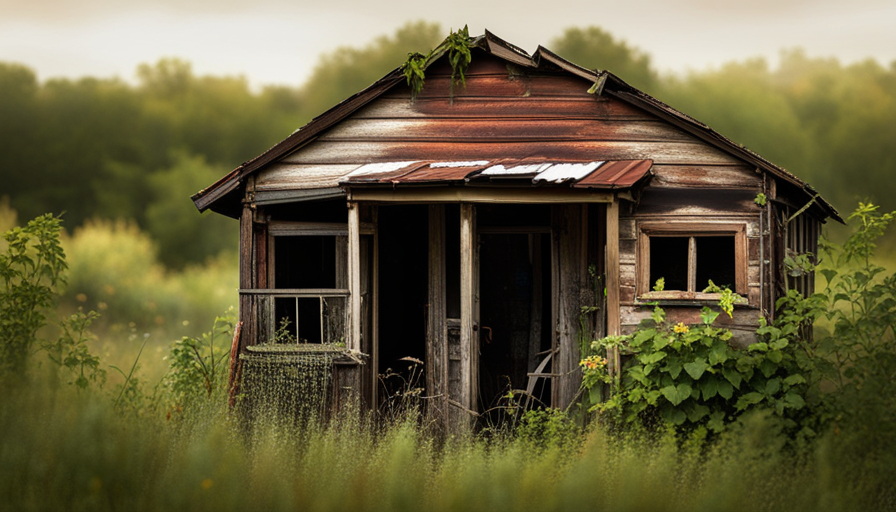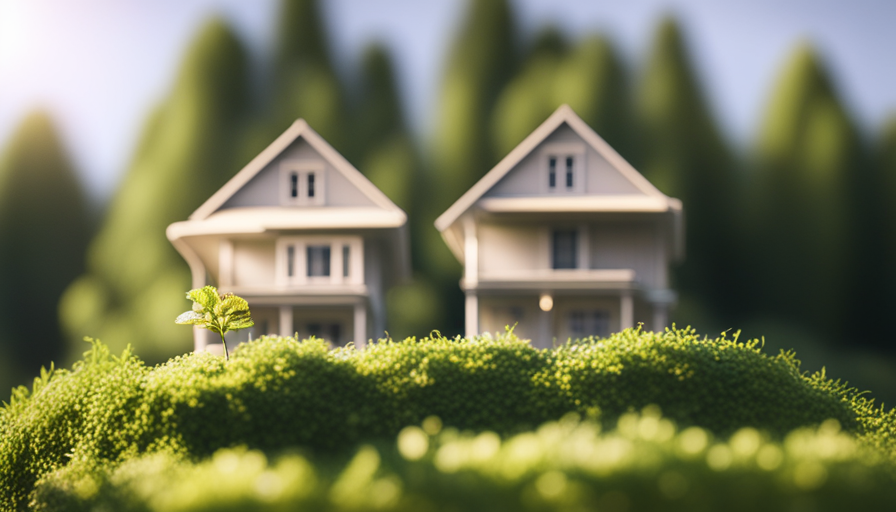Are you looking to build a miniature home inspired by Little Lizard & Tiny Turtle? If you are, then you’re in luck! Creating a small house that reflects the popular Minecraft trend is not only fun, but it also showcases your creativity and design skills.
In this article, we will guide you through the process of creating a small house that captures the essence of the Little Lizard & Tiny Turtle style. We’ll show you how to choose the right materials, design efficient spaces, and maximize storage in your small house. We’ll also provide tips on adding personal touches and decorations to make your house truly unique.
Additionally, we’ll explore ways to utilize outdoor spaces and build on different types of terrain. And if you’re looking to share your creation with others, we’ll even give you tips on showcasing your small house in Minecraft videos.
So, let’s dive in and discover the secrets of making a small house in Little Lizard & Tiny Turtle style!
Key Takeaways
- Utilize vertical space and clever storage solutions to maximize storage in a small house
- Incorporate sustainable materials and energy-efficient windows for a more sustainable and eco-friendly house
- Prioritize functional areas and activities in the layout to create efficient and functional spaces
- Personalize the house with DIY decorations and personalized home accents to add a unique touch.
Understanding the Little Lizard & Tiny Turtle Style
If you want to truly understand the Little Lizard & Tiny Turtle style, you’ve got to appreciate their unique and innovative approach to building small houses. These two builders have mastered the art of designing unique exteriors that capture the imagination and stand out from the crowd.
From whimsical treehouses to cozy cottages, they create homes that are not only functional but also visually stunning.
One key aspect of their style is the utilization of vertical space. Little Lizard & Tiny Turtle understand that in a small house, every inch counts. They incorporate clever storage solutions, such as built-in shelves and cabinets that make use of vertical walls. This allows for more floor space and a cleaner, clutter-free living area.
By incorporating these design elements, they have truly revolutionized the way small houses are built. Their houses are not just tiny versions of regular homes; they are unique and imaginative creations that inspire and delight.
Now that you have a better understanding of the Little Lizard & Tiny Turtle style, let’s move on to the next step: choosing the right materials for your small house.
Choosing the Right Materials for Your Small House
Selecting the appropriate materials for your cozy abode is like handpicking the perfect ingredients for a delectable recipe. To ensure a sustainable and budget-friendly small house in the Little Lizard & Tiny Turtle style, consider the following options:
-
Recycled Materials: Opt for materials that have been repurposed or recycled, such as reclaimed wood for flooring or countertops. This not only reduces waste but also adds a unique character to your small house.
-
Energy-Efficient Windows: Invest in high-quality, energy-efficient windows to maximize natural light and minimize heat loss. Double-glazed or Low-E windows can help save on energy bills in the long run.
-
Insulation: Choose insulation materials that provide excellent thermal performance, such as cellulose or spray foam. Proper insulation will keep your small house comfortable throughout the year and reduce energy consumption.
-
Sustainable Flooring: Consider eco-friendly flooring options like bamboo, cork, or reclaimed wood. These materials are durable, stylish, and have a lower environmental impact compared to traditional hardwood.
By selecting sustainable materials and budget-friendly options for your small house, you can create an environmentally conscious and cost-effective living space. Now, let’s delve into the next section about designing efficient spaces.
Designing Efficient Spaces
To optimize the functionality and utilization of your cozy abode, consider incorporating smart design principles that maximize space efficiency. Maximizing space is crucial when designing a small house, and there are several design trends that can help you achieve this goal.
One popular trend is the use of multi-purpose furniture, such as beds with built-in storage or collapsible tables that can be tucked away when not in use. Another trend is the use of open floor plans, which create a seamless flow between different areas of the house and make the space feel larger. Additionally, incorporating ample natural light can make a small house feel more open and spacious.
When designing the layout of your small house, it’s important to carefully consider each space and how it will be used. Think about the activities that will take place in each area and design accordingly. For example, if you enjoy cooking and entertaining, prioritize a functional and well-equipped kitchen area. If you work from home, create a designated workspace that is separate from your living area to help maintain focus and productivity.
By incorporating these space-saving design principles, you can create a small house that feels spacious and efficient.
In the next section, we will explore how to create cozy living areas that are perfect for relaxation and leisure.
Creating Cozy Living Areas
Enhance the ambience of your compact dwelling by curating intimate and inviting living spaces. When designing a small house in Little Lizard & Tiny Turtle, it’s essential to maximize comfort and create multi-purpose areas.
To achieve this, focus on selecting furniture and decor that are both functional and cozy. Opt for comfortable seating options, such as plush sofas and armchairs, that invite relaxation and provide a sense of warmth. Consider incorporating soft textiles, like throw blankets and accent pillows, to add texture and enhance the coziness of the space.
To make the most of limited square footage, create multi-purpose areas that serve multiple functions. For example, a small dining table can double as a workspace during the day. Invest in furniture with built-in storage solutions, such as ottomans with hidden compartments or coffee tables with drawers, to maximize functionality while minimizing clutter.
By maximizing comfort and creating multi-purpose areas, you can transform your small house into a cozy and efficient living space. Transitioning into the subsequent section about maximizing storage in a small house, it’s important to find creative solutions that optimize every inch of available space.
Maximizing Storage in a Small House
Maximize the storage potential in your compact dwelling by utilizing creative solutions that make the most of every inch of available space. When organizing small spaces effectively, it’s important to think vertically and make use of any unused wall space.
Install shelves or floating cabinets to store books, decorative items, or even kitchen supplies. Use hooks or pegboards to hang pots, pans, and utensils, freeing up valuable drawer space.
Another effective way to maximize storage in a small house is by investing in multi-functional furniture. Look for ottomans or coffee tables with hidden storage compartments, allowing you to store blankets, magazines, or even extra pillows. Consider a bed with built-in drawers or a wardrobe that doubles as a room divider. These versatile pieces not only provide storage but also help to keep your living areas clutter-free.
In addition, don’t overlook the potential of underutilized spaces such as under the stairs or in awkward corners. Install custom-built cabinets or shelving units to make the most of these areas. Utilize storage containers or baskets to keep items organized and easily accessible.
By maximizing storage in a small house and organizing effectively, you can create a more spacious and clutter-free living environment.
In the next section, we will explore the benefits of incorporating functional furniture into your compact dwelling.
Incorporating Functional Furniture
Revamp your compact dwelling with furniture that serves multiple functions, making your space more practical and stylish. When it comes to designing a small house in Little Lizard & Tiny Turtle, incorporating multi-purpose furniture is key.
Optimize your space by choosing pieces that have built-in storage capabilities. Look for sofas or ottomans with hidden compartments, beds with drawers underneath, or coffee tables that double as a workspace or dining table. These furniture pieces not only provide extra storage space but also maximize functionality in your small house.
Incorporating multi-purpose furniture allows you to make the most of every inch in your small house. Instead of cluttering the limited floor space with separate storage units, you can seamlessly integrate storage solutions into your furniture. This not only creates a more streamlined and organized look but also frees up valuable space for other activities and furniture arrangements.
By optimizing space with built-in storage, you can keep your small house tidy and clutter-free, making it feel more open and spacious. Now that you’ve learned how to optimize your space with functional furniture, let’s explore the next step of adding personal touches and decorations to make your small house in Little Lizard & Tiny Turtle truly feel like home.
Adding Personal Touches and Decorations
Adding personal touches and decorations creates a warm and inviting atmosphere in your compact abode, turning it into a cozy sanctuary that truly reflects your unique personality.
To make your small house in Little Lizard & Tiny Turtle feel like home, here are some DIY decoration ideas and personalized home accents you can incorporate:
-
Wall Art and Gallery Displays
-
Hang a gallery of your favorite family photos or artwork to add a personal touch to the walls.
-
Create a feature wall using removable wallpaper or decals in patterns that resonate with your style.
-
Textiles and Soft Furnishings
-
Use cozy throw blankets and decorative pillows to add color and texture to your seating areas.
-
Hang curtains that complement your overall design scheme to add a touch of elegance.
By incorporating these DIY decoration ideas and personalized home accents, you can transform your small house into a space that truly feels like your own.
In the next section on utilizing outdoor spaces, we’ll explore how you can extend the coziness of your abode to the great outdoors.
Utilizing Outdoor Spaces
Now that you’ve added your personal touches and decorations to your small house in Little Lizard & Tiny Turtle, it’s time to make the most of your outdoor spaces.
Despite the limited area, there are still plenty of opportunities for outdoor entertainment and gardening in small spaces.
To maximize your outdoor entertainment options, consider creating a cozy seating area where you can relax and enjoy the fresh air. Adding some comfortable outdoor furniture and maybe even a small fire pit can create a welcoming atmosphere for gatherings with family and friends. Additionally, incorporating some string lights or lanterns can add a touch of ambiance to your outdoor space.
When it comes to gardening in small spaces, vertical gardening can be a game-changer. Utilize walls, fences, or even hanging baskets to grow herbs, flowers, or small vegetables. You can also opt for container gardening, using pots or raised beds to grow your favorite plants. Just make sure to choose plants that thrive in smaller spaces and don’t require a lot of room to spread out.
As you start planning your outdoor spaces, keep in mind that different terrains may require different techniques for building. In the next section, we will provide you with some helpful tips for building on different terrain without compromising the stability and functionality of your small house.
Tips for Building on Different Terrain
Building on different terrain can be a challenge, but with these helpful tips, you can ensure the stability and functionality of your cozy outdoor space. When dealing with uneven ground, it’s important to level the area before building. This can be achieved by adding soil or using retaining walls to create a flat surface. Additionally, constructing a strong foundation is crucial for stability. Consider using concrete footings or piers to support the weight of your small house.
Utilizing limited space is another aspect to consider. To make the most of your outdoor area, think vertically. Incorporate multi-level decks or balconies to maximize the use of space. You can also integrate storage solutions, such as built-in cabinets or hidden compartments, to keep your belongings organized without taking up valuable floor space.
To better understand the tips for building on different terrain and utilizing limited space, refer to the table below:
| Tips for Building on Different Terrain | Tips for Utilizing Limited Space |
|---|---|
| Level the ground before building | Think vertically |
| Use retaining walls or add soil | Incorporate multi-level decks |
| Construct a strong foundation | Utilize built-in storage solutions |
By following these tips, you can create a stable and functional small house even on uneven ground while making the most of your limited space. Now, let’s transition into the next section and explore how to showcase your small house in Minecraft videos.
Showcasing Your Small House in Minecraft Videos
Despite the challenges, showcasing your cozy outdoor space in Minecraft videos can truly be a piece of cake. By utilizing the natural surroundings and incorporating unique architectural features, you can create a small house that stands out from the rest.
When it comes to making a small house in Little Lizard & Tiny Turtle, it’s important to take advantage of the natural environment. Consider building your house near a picturesque lake or on a hill with a stunning view. This will not only enhance the overall aesthetic of your video, but it will also provide a sense of tranquility and charm to your small house.
In addition to the natural surroundings, incorporating unique architectural features can make your small house truly stand out. Consider adding a wrap-around porch with cozy seating areas, or a rooftop garden filled with colorful flowers and plants. These features not only add visual interest to your video, but they also create a welcoming and inviting atmosphere for viewers.
By utilizing the natural surroundings and incorporating unique architectural features, you can create a small house in Little Lizard & Tiny Turtle that is both visually appealing and functional. So go ahead and show off your cozy outdoor space in Minecraft videos, and let your creativity shine!
Frequently Asked Questions
How do you choose the right location for building a small house in Little Lizard & Tiny Turtle style?
When choosing the right location for a small house in the style of Little Lizard & Tiny Turtle, consider the layout and size of the furniture you intend to use. Ensure that the space allows for easy movement and placement of the furniture pieces.
Additionally, organizing storage in a small house is crucial. Opt for multifunctional furniture with built-in storage solutions, utilize vertical space, and declutter regularly to maximize the available storage space in your small house.
What are some tips for maximizing natural light in a small house?
To maximize natural light in a small house, start by choosing the right paint colors. Lighter shades like whites, creams, and pastels can reflect light and make a space feel brighter.
Additionally, strategically placing mirrors can amplify natural light by reflecting it throughout the room. Consider placing mirrors opposite windows or in areas where light is limited.
These simple tips can create a brighter and more inviting atmosphere in your small house.
How can I create a functional and stylish kitchen in a small house?
Designing a functional and stylish kitchen in a small house can be a challenge, but with the right tips for organizing a small kitchen space, you can create a space that’s both practical and visually appealing.
Start by maximizing storage with clever cabinet solutions and utilizing vertical space. Opt for multipurpose appliances and consider open shelving to add a modern touch.
Keep the color palette light and bright to create an illusion of a larger space.
What are some creative ways to incorporate greenery and plants into a small house design?
To bring a touch of nature into your small house, consider incorporating vertical gardens and hanging planters. These creative solutions not only add greenery, but also maximize space utilization.
Vertical gardens allow you to grow plants vertically, either on walls or in specially designed structures. Hanging planters can be suspended from the ceiling or mounted on walls, creating a beautiful display of cascading foliage.
These unique and space-saving options will infuse your small house with a refreshing and natural ambiance.
Are there any specific building codes or regulations to consider when constructing a small house in Little Lizard & Tiny Turtle style?
When constructing a small house in the style of Little Lizard & Tiny Turtle, it’s important to consider specific building codes and regulations. The tiny house construction process may present unique challenges, such as limited space and structural requirements.
It’s crucial to research and comply with local zoning laws, permits, and building codes to ensure that your small house meets safety standards. Consulting with professionals in the field can help navigate and adhere to these regulations.
Conclusion
In conclusion, building a small house in the Little Lizard & Tiny Turtle style can be a rewarding and creative endeavor. By carefully selecting the right materials and designing efficient spaces, you can create a cozy and functional living area.
Don’t forget to maximize storage and add personal touches to make the house feel like home. Utilizing outdoor spaces and building on different terrains can also add unique elements to your small house.
So, grab your pickaxe and get ready to showcase your Minecraft masterpiece! It’s time to bring your small house dreams to life in the pixelated world of Minecraft.
Hi, I’m Emma. I’m the Editor in Chief of Tiny House 43, a blog all about tiny houses. While tree houses are often associated with childhood, they can be the perfect adult retreat. They offer a cozy space to relax and unwind, surrounded by nature. And since they’re typically built on stilts or raised platforms, they offer stunning views that traditional homes simply can’t match. If you’re looking for a unique and romantic getaway, a tree house tiny house might just be the perfect option.
